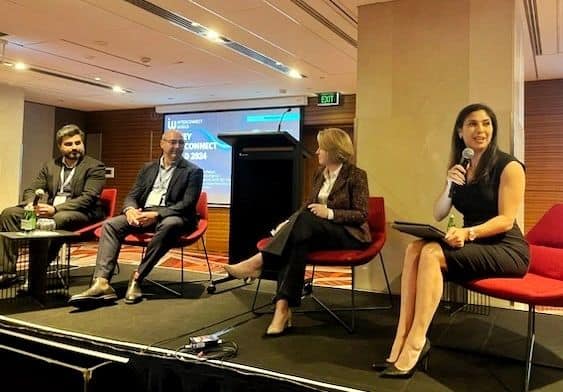The future of 5G in Australia was the focal point of a recent panel discussion during Sydney Interconnect World 2024
The session explored opportunities, challenges, and success stories in the deployment and adoption of 5G technology, featuring three industry leaders:
- Stephen Farrugia, Chief Technology Officer (CTO) of BAI Communications (BAI)
- Louise Hyland, Chief Executive Officer (CEO) of the Australian Mobile Telecommunications Association (AMTA)
- Amin Javed, Head of Products at TPG Telecom.
The opportunities enabled through the adoption of 5G
The session began with an introduction where each panellist shared their perspectives on the biggest opportunities presented by 5G. Stephen Farrugia highlighted the transformative potential of 5G in enhancing connectivity and driving innovation across various sectors. Louise Hyland pointed to the economic benefits, emphasising the potential $67 billion GDP boost by 2030, with an additional $27 billion possible through accelerated adoption. Amin Javed underscored the impact on consumer experiences and the promise of new services and applications.
Adoption and deployment challenges
The discussion then turned to the challenges faced in adopting and deploying 5G. Stephen outlined key technical hurdles, including long-term access to spectrum and the availability of 5G standalone equipment. Amin highlighted TPG Telecom’s obstacles, such as regulatory constraints and the cost of deployment. And Louise addressed how AMTA is tackling regulatory and policy issues, striving to create an environment conducive to 5G growth.
Success stories in 5G adoption
The panellists shared success stories to illustrate the tangible benefits and progress of 5G deployment. Stephen discussed BAI Communications’ successful trials in the agricultural and media sectors, and highlighted BAI’s sister company Boldyn Networks’ operations of over 50 private networks in mining, ports, councils, utilities, and health sectors.
Amin shared TPG Telecom’s progress in expanding its 5G network across major Australian cities. He emphasised the role of innovative partnerships in introducing new services that leverage the high-speed, low-latency capabilities of 5G.
And Louise spoke about AMTA’s pivotal role in shaping telecommunications infrastructure planning reforms. She pointed to their extensive thought leadership work including the ‘Model State and Territory Planning Framework’ and ‘Guidance on Deploying Telecommunications Infrastructure in Growth Areas’. Louise also spotlighted key recommendations from the Deloitte Access Economics report, “5G Unleashed: Realising the potential of the next generation of 5G technology.”
Overcoming barriers
The conversation then focused on overcoming the barriers to 5G deployment. Stephen Farrugia discussed mitigating technical challenges, particularly related to security risks, using private 5G mobile networks. From a network provider perspective, he emphasised the importance of ISO 27001 accreditation and 24/7/365 network monitoring and reporting to ensure data security and operational reliability.
Louise Hyland advocated for a regulatory environment that supports innovation and investment in 5G. She stressed the critical role of collaboration between industry stakeholders and the government to enable efficient infrastructure deployment and the development of a workforce equipped for future technologies.
Ensuring smooth adoption
Finally, the panellists discussed the key components necessary for smooth and accelerated 5G adoption. They highlighted the importance of regulatory frameworks, infrastructure investment, technical innovations, stakeholder collaboration, consumer education, and business readiness. These elements, they agreed, are crucial for harnessing the full potential of 5G and ensuring that its benefits are widely realised across Australia.
This insightful panel discussion provided a comprehensive overview of the current state and future prospects of 5G in Australia, underlining the collaborative efforts required to unlock its full potential.







